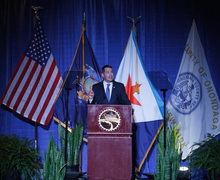Syracuse University community members discuss diversity and inclusion at campus forum
Luke Rafferty | Staff Photographer
"Express Yourself: A Syracuse University Community Conversation on Diversity and Inclusion" was held on Thursday afternoon in Hendricks Chapel. During the forum, SU community members discussed their experiences with diversity on campus.
UPDATED: Oct. 2, 8:04 p.m.
Syracuse University administrators, faculty, staff and students filed into Hendricks Chapel Thursday afternoon for a campus-wide forum on diversity and inclusion.
At the beginning of the event, Chancellor Kent Syverud briefly spoke to the audience.
“I’m here today to listen,” Syverud said.
The more than two-hour long forum was split into several parts. After a brief introduction by Syverud participants discussed two sets of questions and then broke into smaller discussion groups. Syverud closed the forum by summing up everything that was discussed and outlining next steps.
When attendees walked up the steps of Hendricks, they passed by a silent protest being held by members of the campus NAACP chapter. As they entered the building, forum participants were handed cards with the hashtag #ExpressSU printed across the top. The card also had two questions on them, which served as the main focus of the discussion section of the forum.
The lower level of Hendricks was nearly full at the start of the forum with the attendees almost evenly split between students and other members of the SU community including faculty, staff and administrators. Syverud was joined by several other administrators, including:
—Vice Chancellor and Provost Eric Spina,
—Dean of Student Affairs Rebecca Reed Kantrowitz
—Dean of Hendricks Chapel Tiffany Steinwert
—Dean of the Martin J. Whitman School of Management Ken Kavajecz
—Director of Athletics Daryl Gross
Syverud told the audience that while the reason for the forum was initially because of the Hanna Strong video, the issues being discussed were much larger.
“The immediate instigation of us being here is one incident, but that one incident resonated with feelings and experiences more broadly,” Syverud said.
Vice Chancellor and Provost Eric Spina and Dean of Student Affairs Rebecca Reed Kantrowitz then addressed several specific requests that student leaders had given the administration. Spina said some of those requests came out of a forum and a rally that were held on Sept. 12 and Sept. 19, respectively.
The requests included:
— More open dialogues.
— More preparation for faculty and students in order to engage in discussions on identity and privilege.
— More involvement from the administration in engaging with student organizations of color.
— Mandatory dialogue class for all students.
— More conversations between the SU Athletics and the student body
— Additional funding for the African American Studies department.
Spina and Kantrowitz offered potential remedies to these demands. One suggestion they made was to create a faculty ambassador program, in which faculty members act as a liaison to certain student organizations. Sylvia Langford, associate vice president of student affairs, and professor Harriet Brown will lead the effort, Kantrowitz said. She also brought up the proposal of a black and Latino caucus of representatives from those student groups.
Spina also suggested creating a student athlete council. This effort is being spearheaded by Rick Burton, a sport management professor, Herm Frazier, deputy director of athletics and Sheila Johnson, director of the office of equal opportunity and inclusion, he said.
Brittany Moore, director of student engagement for the Student Association, facilitated the conversation. The first question discussed was “What challenges have you faced at Syracuse University?”
Students spoke about issues of entitlement, self-segregation and marginalization on campus. Multiple students questioned the meaning of diversity as well.
“It’s not only what does diversity mean to us, but what does it mean to the university,” said Hugh Pringle, a junior in the College of Arts and Sciences.
The only non-student to speak during the challenges portion of the discussion was Mara Sapon-Shevin, a professor in the School of Education, who said she didn’t believe the issues happening on campus were acceptable either. She added that she has previously served on multiple diversity committees that had made suggestions to the administration, but nothing happened.
“I don’t want to be known as a university that is moving fast backward,” she said, as the crowd applauded.
The second portion of the discussion section was guided by the questions, “Where have you found hope at Syracuse University?” and “What do you hope for Syracuse University?” Students and faculty shared their desires for more dialogue, more safe spaces on campus and for the administration to actually act on the ideas presented at the forum.
“I just have one hope,” said Wayne Smith, a senior. “That the administration acts on these ideas. We can continue having these panels, but we need to act on these ideas.”
Those in attendance were then asked to break off into groups of five or six and talk about issues they faced and saw happening on campus. Syverud joined a group of students and faculty, and took notes as he listened.
At the end of the forum, Syverud stood at the podium again and recapped what had taken place during the previous two hours. He said he had been actively listening and taking notes throughout. He went through the issues he found were most prominently discussed. Syverud also emphasized the need for the discussion to continue with people not in attendance.
One common theme Syverud said he noticed was that certain students feel that others assume they’re only at SU because of affirmative action. He has also seen this at other universities he’s worked at, he added.
“We want a culture where everyone that belongs here is everybody that is here,” Syverud said.
He added that it’s important to “start a feedback loop” to ensure that suggestions made at the forum are actually heard and acted upon. He closed by saying he was “immediately going to regroup,” and go over the information presented by Spina and Kantrowitz.
Published on October 2, 2014 at 7:26 pm
Contact Brett: blsamuel@syr.edu | @Brett_Samuels27





